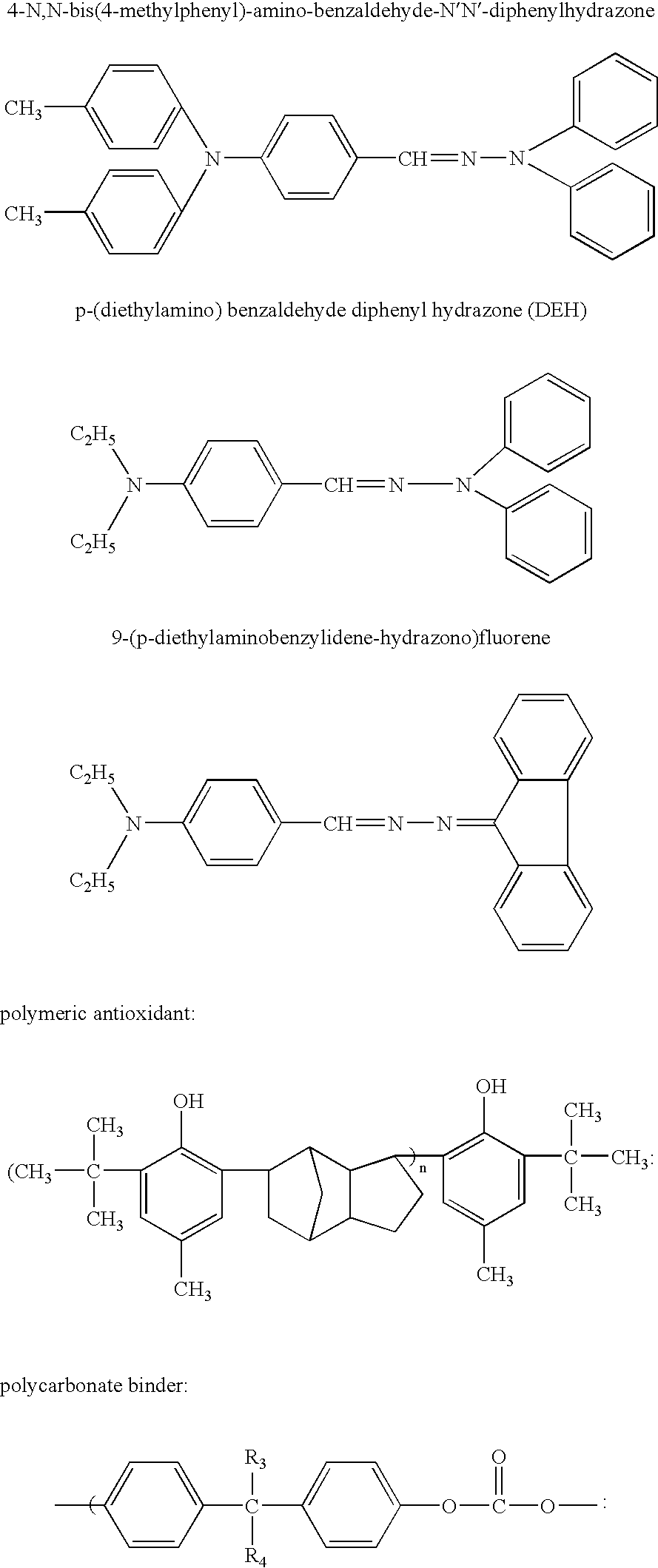Long life photoconductors
a photoconductor and long-life technology, applied in the field of improved photoconductor, can solve the problems of longer and achieve the effect of improving wear resistance and prolonging the useful life of the photoconductor
- Summary
- Abstract
- Description
- Claims
- Application Information
AI Technical Summary
Benefits of technology
Problems solved by technology
Method used
Image
Examples
example a
[0011] Charge Generation Layer:
[0012] CG dispersion consists of titanyl phthalocyanine (type IV), and polyvinylbutyral (BX-1, Sekisui Chemical Co.) at a ratio of 67 / 33 in a mixture of 2-butanone and cyclohexanone. The CG dispersion was dip-coated on the aluminum substrate and dried at 100° C. for 15 minutes to give a thickness less than 1 μm, and more preferably, 0.2-0.3 μm.
[0013] Charge Transport Layer (22% 4-N,N-bis(4-methylphenyl)-amino-benzaldehyde-N′,N′-diphenyl-hydrazone):
[0014] A charge transport formulation containing 22% was prepared by dissolving 4-N,N-bis(4-methylphenyl)-amino-benzaldehyde-N′,N′-diphenylhydrazone (16.5 g), and polycarbonate A (58.5 g, MAKROLON 5208, Bayer Inc.) in a mixed solvent of tetrahydrofuran and 1,4-dioxane. The charge transport layer was coated on top of the charge generation layer and cured at 100° C. for 1 hour to give a thickness of 25-27 μm.
example b
[0015] Charge Generation Layer:
[0016] CG dispersion consists of titanyl phthalocyanine (type IV), polyvinylbutyral (Sekisui Chemical Co.), polyhydroxystyrene and poly(methyl-phenyl)siloxane in a ratio of 45 / 27.5 / 24.75 / 2.75 in a mixture of 2-butanone and cyclohexanone. The CG dispersion was dip-coated on aluminum substrate and dried at 100° C. for 15 minutes to give a thickness less than 1 μm, and more preferably, 0.2-0.3 μm.
[0017] Charge Transport Layer (22% 4-N,N-bis(4-methylphenyl)-amino-benzaldehyde-N′,N′-diphenylhydrazone:
[0018] Same as Example A
example c
[0019] Charge Generation Layer:
[0020] Same as in Example A
[0021] Charge Transport Layer (22% 4-N,N-bis(4-methylphenyl)-amino-benzaldehyde-N′,N′-diphenylhydrazone and 1.0% 9-(p-diethylaminobenzylidene-hydrazono)fluorene:
[0022] A charge transport formulation containing 22% was prepared by dissolving 4-N,N-bis(4-methylphenyl)-amino-benzaldehyde-N′,N′-diphenylhydrazone (16.5 g), 9-(p-diethylaminobenzylidene-hydrazono)fluorene (0.7 g) and polycarbonate A (57.7 g, MAKROLON 5208, Bayer Inc.) in a mixed solvent of tetrahydrofuran and 1,4-dioxane. The charge transport layer was coated on top of the charge generation layer and cured at 100° C. for 1 hour to give a thickness of 25-27 μm.
PUM
| Property | Measurement | Unit |
|---|---|---|
| Fraction | aaaaa | aaaaa |
| Percent by mass | aaaaa | aaaaa |
| Percent by mass | aaaaa | aaaaa |
Abstract
Description
Claims
Application Information
 Login to View More
Login to View More - R&D
- Intellectual Property
- Life Sciences
- Materials
- Tech Scout
- Unparalleled Data Quality
- Higher Quality Content
- 60% Fewer Hallucinations
Browse by: Latest US Patents, China's latest patents, Technical Efficacy Thesaurus, Application Domain, Technology Topic, Popular Technical Reports.
© 2025 PatSnap. All rights reserved.Legal|Privacy policy|Modern Slavery Act Transparency Statement|Sitemap|About US| Contact US: help@patsnap.com

